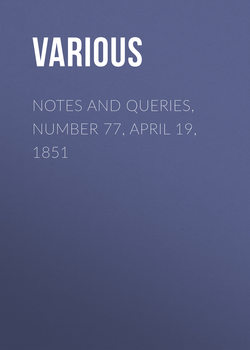Читать книгу Notes and Queries, Number 77, April 19, 1851 - Various - Страница 6
Queries
ОглавлениеPORTRAITS OF SPENSER
The engraved portraits of Spenser differ so much from each other as to throw doubts on their resemblance to the poet.
I have now before me the following:
1. That prefixed to Bell's edition, 1777, engraved by Cook from "an original in Lord Chesterfield's collection."
2. Prefixed to an edition in one volume published by Spiers, 1840.
3. Prefixed to Moxon's edition, 1845.
We are not told from what paintings Nos. 2. and 3. are engraved, but they resemble each other, and are somewhat like that in Bell's edition; so I shall set these three down as forming one class of portraits. No. 2. has, however, a curious inscription, Edmund Spenser, obiit 1559, which would lead us to reject it altogether, and look on it as an imaginary likeness.
4. The portrait in Pickering's Aldine edition, 1839: this bears no resemblance, either in costume or features, to those already mentioned; but, if I mistake not, is like that in Todd's edition, published in 1805,—we may call these a second class.
An original portrait of Spenser is said to be in Lord Chesterfield's collection; another in Duplin Castle, the seat of Lord Kinnoul (of this there is a copy at Althorpe by Sir Henry Raeburn). Mr. Wright, in his Memorials of Cambridge, mentions a portrait at Pembroke College, "a copy by Wilson," but he does not say from what original: Mr. Craik, in Spenser and his Writings, speaks of two as being in this college.
The writer thinks he recollects a law-suit relative to a portrait of the poet, which had been sold to the late Sir Robert Peel, and which was stated to have come from Ireland. Perhaps some of your readers could give information respecting this picture.
It is clear, if the first three are all from the Chesterfield original, that this painting, and the one from which Mr. Pickering's is taken, cannot both be portraits of Spenser. The object of this Query is to ascertain, if possible, which engraving, or class of engravings, resembles the poet.
E. M. B.
THE VENDACE
The very remarkable fish called the Vendace is to be found but in one place in the three kingdoms,—the Castle Loch of Lochmaben, a parish to the south of Dumfriesshire in Scotland. The Vendace, it is said, derives its name from Vendois in France, and was brought to this country by one of the James's. This, however, is mere conjecture, and, from its habits, highly improbable—because they die the moment they are either touched or exposed to the air.
According to Mr. Stewart (Elements of Natural Hist.), the Vendace belongs to a species which he calls Salmo albula, or the "Juvangis."
"This species," he adds, "is found in Lochmaben in Scotland, and nowhere else: it is said to have been carried thither from England in the time of Robert the Bruce."
Mr. Stewart describes the fish, but from his description it is evident he has never seen it. The following one is exact:—
"This beautiful fish measures from four to six inches in length, and tapers gradually to the tail. When taken out of the water, it has a bright silvery white appearance, with a slight tendency to a light blue along the back and part of the sides. In size it resembles a small herring or par, but particularly the former, not only in the mouth and external appearance, but also in the anatomical structure. Upon the top of the head
